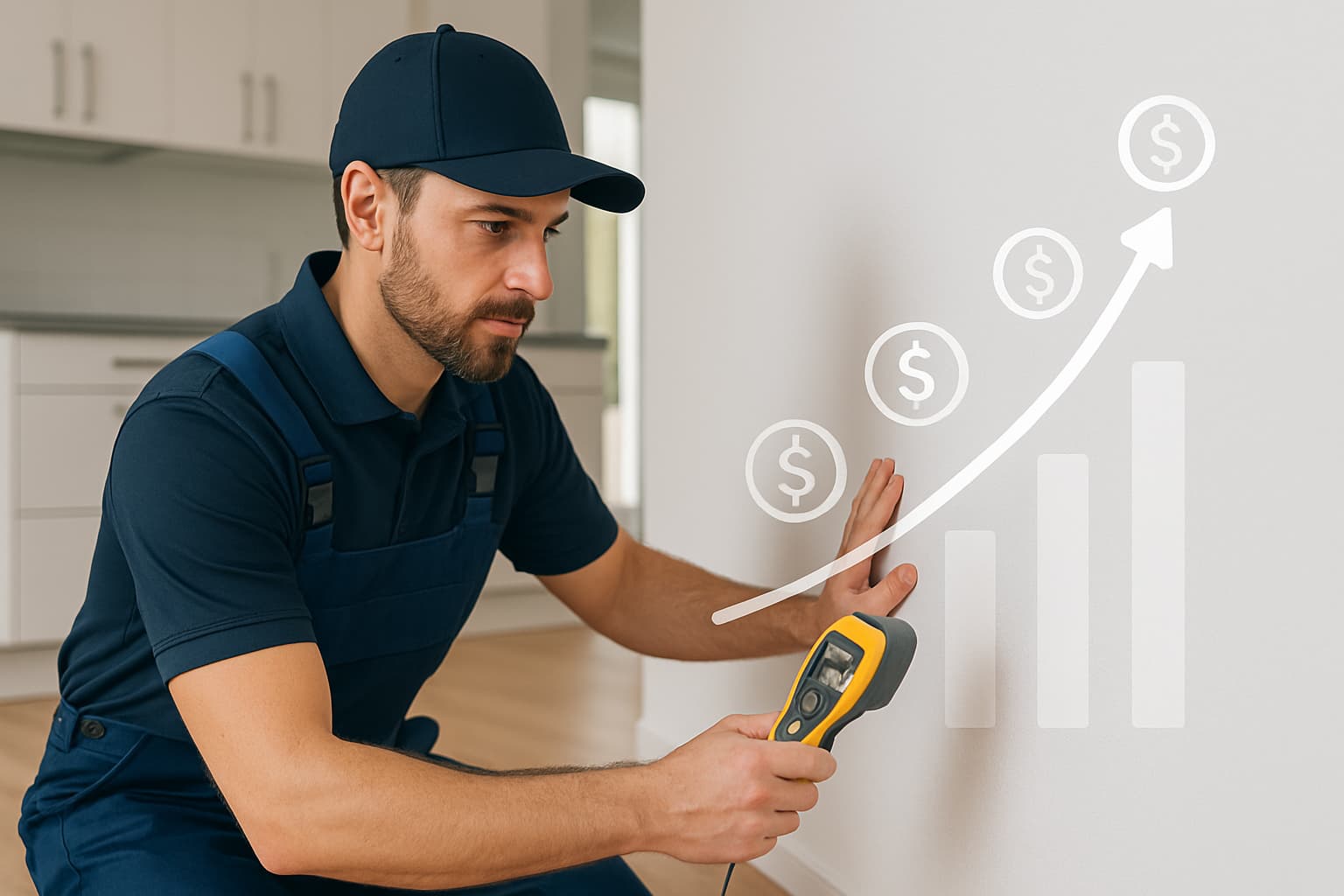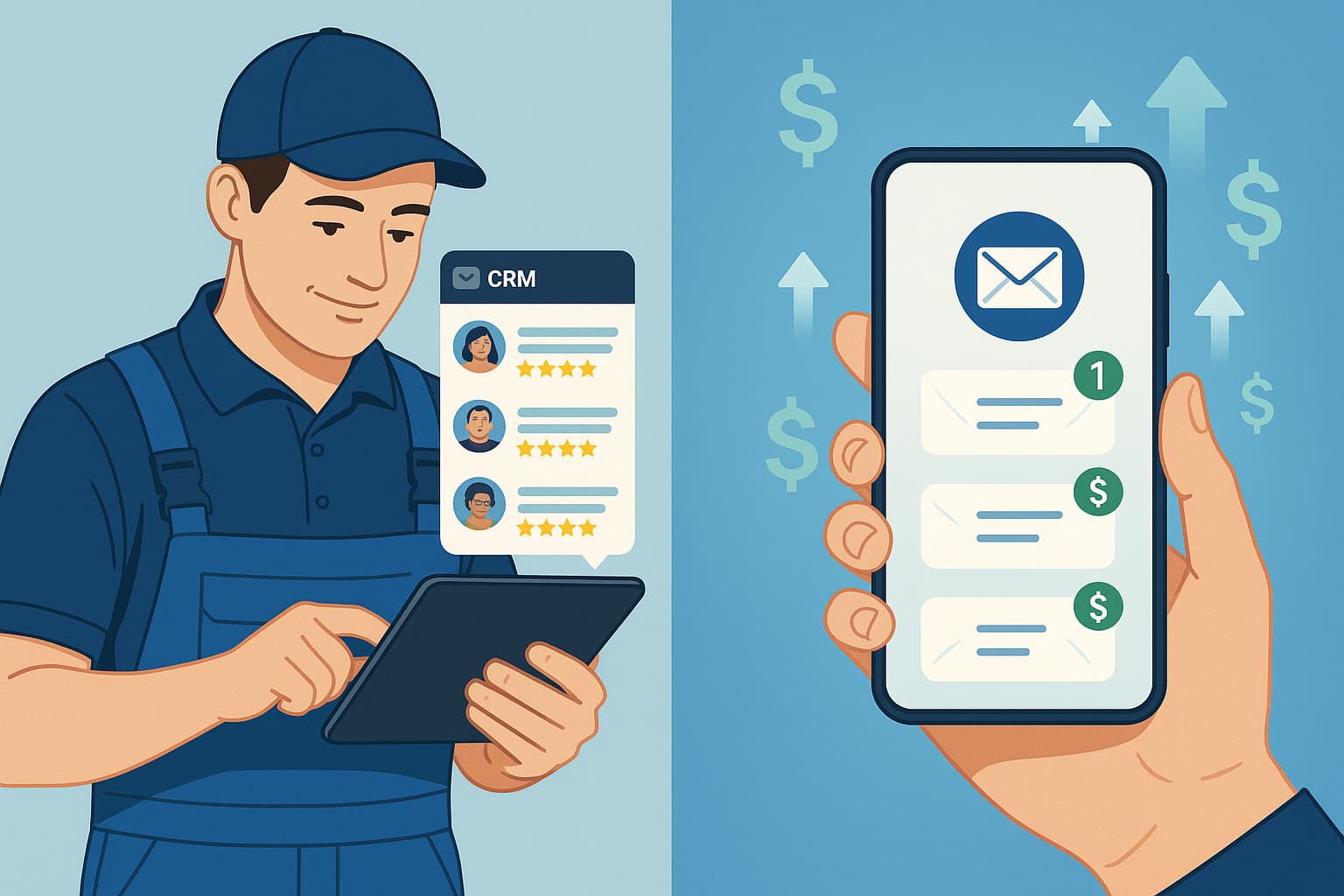How to Grow Revenue Without Getting More Water Damage Leads
Running a water damage business is tough. You spend money on water damage leads and expensive equipment. But here's the thing - most companies focus on getting more jobs instead of making more from each job.
The secret isn't just getting more calls through water damage marketing. It's making each job worth more money. This guide shows you how to package your services and train your team to boost your revenue.
While maximizing job value is crucial, you still need a steady flow of quality leads to grow your business. Build a solid foundation with how to get water damage leads in 2025: the ultimate guide to ensure you have enough high-quality prospects to apply these revenue optimization strategies.
You'll learn how to create service packages that customers want. Plus, you'll discover how to explain these packages so customers say yes. Ready to make more from every water damage call?
Table of Contents
Why Job Value Matters More
Find Money You're Already Losing
Create High-Value Service Packages
Use the Good-Better-Best Model
Train Your Team to Sell Value
Talk to Customers the Right Way
Use Industry Standards to Justify Work
Bill Insurance Companies Correctly
Tools to Manage Your Packages
Track Your Success
Why Job Value Matters More
Most water damage companies chase more restoration leads. They spend money on marketing and ads. But smart companies focus on something different - average job value.
Your job value shows how much money you make per lead. The restoration business needs expensive equipment and skilled workers. You need to make good money from each job to cover your costs.
Here's what the numbers show. Good restoration companies make 40% to 75% profit on their work. Water damage jobs can make you 50% to 80% profit. That's huge money if you do it right.
Think about it this way. Getting new customers through pay-per-call leads costs money. You pay for ads, sales calls, and paperwork. But making more money from jobs you already have? That's pure profit.
Want to know the secret? Companies that package their water restoration services make way more money than companies that just do basic water mitigation.
Find Money You're Already Losing
Before you start making more money, stop losing the money you already earn. Most water damage companies leak revenue without knowing it.
Common ways you lose money:
Giving discounts for no good reason
Not charging for emergency after-hours calls
Making mistakes when you write estimates
Skipping steps you should always do
Not explaining why customers need certain services
Poor paperwork that insurance companies reject
Here's a big problem many companies face. Insurance companies now use computers to check your claims. These systems look for mistakes and missing information. If your paperwork isn't perfect, they reject your claim. This affects your conversion rate and cash flow.
You need to fix these problems first. If you're already losing money on basic jobs, packaging won't help much.
Start by checking these areas:
Review your estimates for errors
Make sure you charge for all services you provide
Train your team on required procedures
Improve your documentation and photos
Create High-Value Service Packages
Smart water damage companies don't just remove water. They solve the whole problem. This means creating packages that give customers everything they need.
Service bundling works like this: You group related services together for one price. Customers get convenience and value. You get higher job values.
Core services every emergency services job needs:
24/7 emergency response
Damage assessment and moisture mapping
Stop the water source
Remove standing water
Set up drying equipment
Remove damaged materials
Basic cleaning and sanitizing
Value-added services that make you more money:
Contents cleaning and storage
Mold prevention treatment
Structural repairs
Specialty drying for hardwood floors
Odor removal
Enhanced sanitization
HVAC cleaning
Document drying
Biohazard cleanup
The key is showing customers why they need more than just water removal. Most water damage creates other problems. Mold can grow. Contents get damaged. Odors develop.
When you package services, customers see the full solution. They understand they're not just buying water removal. They're buying peace of mind.
Use the Good-Better-Best Model
The easiest way to package your services is with three options. This gives customers choices and makes your highest package look reasonable.
Good: Emergency Mitigation Package This covers the basics every job needs:
24/7 emergency response
Damage assessment
Stop water source
Extract standing water
Set up drying equipment
Remove damaged materials
Basic cleaning
Daily moisture monitoring
Better: Enhanced Restoration Package
Everything in Good, plus:
Enhanced cleaning and disinfection
Mold prevention treatment
Basic contents cleaning
Minor repairs like baseboard replacement
HVAC system check
Best: Comprehensive Recovery Package Everything in Better, plus:
Full contents pack-out and restoration
Advanced mold remediation if needed
Complete structural repairs
Advanced odor removal
HVAC duct cleaning
Final detailed cleaning
Help with insurance paperwork
Most customers pick the middle option. But many upgrade to the Best package when they understand the value.
You can also offer add-on services like document restoration or electronics cleaning. These extras boost your job value even more.
Train Your Team to Sell Value
Your technicians are your best salespeople. They're in the customer's home when emotions run high. They see problems the customer might miss.
Before your technicians can sell value in person, you need to convert the initial phone calls into appointments. Master how to book more water damage jobs with 5 proven phone scripts to ensure quality leads become opportunities for your team to present comprehensive service packages.
But most techs only think about fixing the immediate problem. You need to train them to be consultants who help customers make good choices.
Teach your techs to:
Listen to customer concerns
Ask questions about their worries
Explain problems in simple terms
Show why certain services prevent future issues
Present options without being pushy
Key mindset shift: Your techs aren't just there to remove water. They're there to solve the customer's problem completely.
When a tech finds mold behind a wall, they shouldn't just mention it. They should explain what happens if you don't treat it properly. They should show the customer options and help them choose the best solution.
Teach techs to handle common objections:
For price concerns:
Acknowledge that cost matters
Explain the long-term value
Compare incomplete work to doing it right
Offer payment options if available
For "is this really necessary" questions:
Reference IICRC standards
Explain risks of skipping steps
Show moisture readings or photos
Give real examples of what can happen
The goal is education, not pressure. When customers understand the risks and benefits, they make better decisions.
Talk to Customers the Right Way
Water damage creates stress and confusion. How you communicate makes a huge difference in whether customers buy your premium packages.
Start with empathy: "I know this is overwhelming. We're here to help you through it."
Explain the process clearly: Tell customers what you'll do and why each step matters. Focus on outcomes they care about - a safe home, preventing future problems, saving their belongings.
Present options simply: Use your Good-Better-Best model. Highlight key differences. Visual aids help customers who feel overwhelmed.
Build credibility: Mention your certifications and experience. Show reviews if appropriate. Explain your commitment to quality work.
Handle objections with facts: When customers question costs or necessity, use industry standards and real examples. Show them moisture readings or photos that prove the extent of damage.
Remember, stressed customers make emotional decisions. Your job is to give them the information they need to make good choices for their family and property.
Use Industry Standards to Justify Work
The IICRC S500 standard gives you powerful backing for comprehensive service packages. This industry standard defines proper water damage restoration procedures.
Reference S500 when you:
Explain why certain procedures are required
Justify removal of contaminated materials
Show why antimicrobial treatments are needed
Defend thorough drying protocols
For example, when a customer questions why you need to remove all the baseboards, explain that S500 requires proper drying behind wall systems. When they ask about mold treatment, reference the standard's requirements for different water categories.
Key phrases to use:
"Industry standard requires..."
"According to IICRC S500..."
"Professional restoration standards call for..."
"To meet the standard of care..."
This shifts the conversation from optional upgrades to required professional procedures. It's harder for customers or insurance adjusters to argue against established industry standards.
Position your comprehensive packages as "S500 Compliant." This adds credibility and justifies higher-value services.
Bill Insurance Companies Correctly
Getting paid for packaged services requires smart billing strategies. Most restoration companies use Xactimate software for estimates. You need to work within this system while maximizing reimbursement.
Xactimate strategies for packages:
Create macros for different service tiers
Add detailed notes explaining why services are needed
Keep line items transparent even in bundled pricing
Use current, accurate pricing for your area
Justify comprehensive scopes with:
Extensive photo documentation
Detailed written narratives explaining the damage
F9 notes linking specific services to observed conditions
References to S500 standards where applicable
For non-covered services:
Clearly separate covered work from upgrades
Get written authorization from homeowners
Bill non-covered work directly to the customer
Establish clear payment terms upfront
Transparency prevents problems later. Make sure everyone understands what insurance covers and what the homeowner pays for.
Pro tip: Always "tell the story of the loss" in your estimate. Explain what happened, what you found, and why each service is necessary. This helps adjusters understand and approve comprehensive scopes.
Tools to Manage Your Packages
Managing service packages effectively requires the right software and systems. You need tools that handle quoting, scheduling, and billing for complex service offerings.
CRM software and job management systems help with:
Creating service package templates
Tracking which packages customers choose
Managing quotes for different service tiers
Scheduling resources for larger scopes
Call tracking for lead generation performance
Popular options include: Jobber, Albi, DASH, JobNimbus, and Encircle. Look for features like service libraries, custom fields, and customer portals.
Estimating software features you need:
Template creation for different tiers
Custom pricing capabilities
Integration with field documentation tools
Integration is key. Your field documentation should flow seamlessly into estimates and billing. This ensures accuracy and supports your justification for comprehensive packages.
Update your processes for:
Standard operating procedures for each package tier
Quality control checklists for complex jobs
Communication between field staff and office
Scheduling systems that account for longer job durations
Track Your Success
You need to measure results to know if your packaging strategy works. Track these key numbers before and after implementing packages.
Essential metrics:
Average job value - your main success indicator
Package adoption rates - which tiers customers choose most
Conversion rate - how often customers upgrade
Profit margins by service tier
Customer satisfaction scores
Lead cost vs job value ratio
Implementation roadmap:
Analyze current performance - Calculate your current AJV and identify revenue leaks
Define service offerings - List all potential services and categorize them
Develop packages - Create 2-3 clear tiers with strong value propositions
Train your team - Focus on consultation skills and package knowledge
Refine billing - Set up Xactimate macros and billing procedures
Use technology - Implement integrated software systems
Monitor and improve - Track results and adjust based on what works
Success indicators:
Higher average job values
More customers choosing premium packages
Fewer price objections
Better customer satisfaction
Improved profit margins
Track these numbers monthly. Look for trends and adjust your packages based on what customers want most.
Ready to Boost Your Water Damage Revenue?
Packaging your water damage services isn't just about making more money. It's about solving customer problems completely while building a stronger, more profitable business.
The companies that succeed focus on value, not just price. They train their teams to educate customers and solve problems. They use industry standards to justify comprehensive work. And they track results to keep improving.
Once you've optimized your average job value and are consistently booking higher-value projects, you'll need to scale your operations to handle increased demand. Learn how to add a second crew and double your revenue from water damage leads to capitalize on your improved profitability per job.
Key takeaways:
Focus on job value, not just job volume
Fix revenue leaks before adding packages
Create clear Good-Better-Best options
Train techs to be consultants, not just workers
Use IICRC standards to justify comprehensive work
Bill insurance correctly and transparently
Invest in the right tools and systems
Track your results and keep improving
The water damage restoration industry rewards companies that provide comprehensive solutions. Customers want their problems solved completely. Insurance companies pay for proper restoration when you justify it correctly.
Smart home services marketing focuses on both getting quality leads and maximizing value from each one. When you improve your Google Business profile visibility and SEO for contractors, you get better leads that convert at higher values.
Beyond initial lead generation, maintaining relationships with past clients creates opportunities for repeat business at premium rates. Implement how to get more water damage calls with emails, SEO, and tracking tools to nurture existing customers who are more likely to accept comprehensive service packages.
Start with one simple package. Train your team. Track your results. Then expand based on what works. Your average job value will increase, and your business will be stronger and more profitable.
Want to get more pay per call water damage leads? Sign up for free with ResultCalls today!

Alex Gambashidze
Marketing Associate at ResultCallsHello everyone! My name is Alex and I write these blogs to help educate small business owners on different ways to grow their business. My goal is to make lead generation as easy as possible for you. After reading these blogs, I hope you leave with some actionable steps that will get you closer to growing your business :)
2,000+
Happy local businesses
See what some of them have to say.


